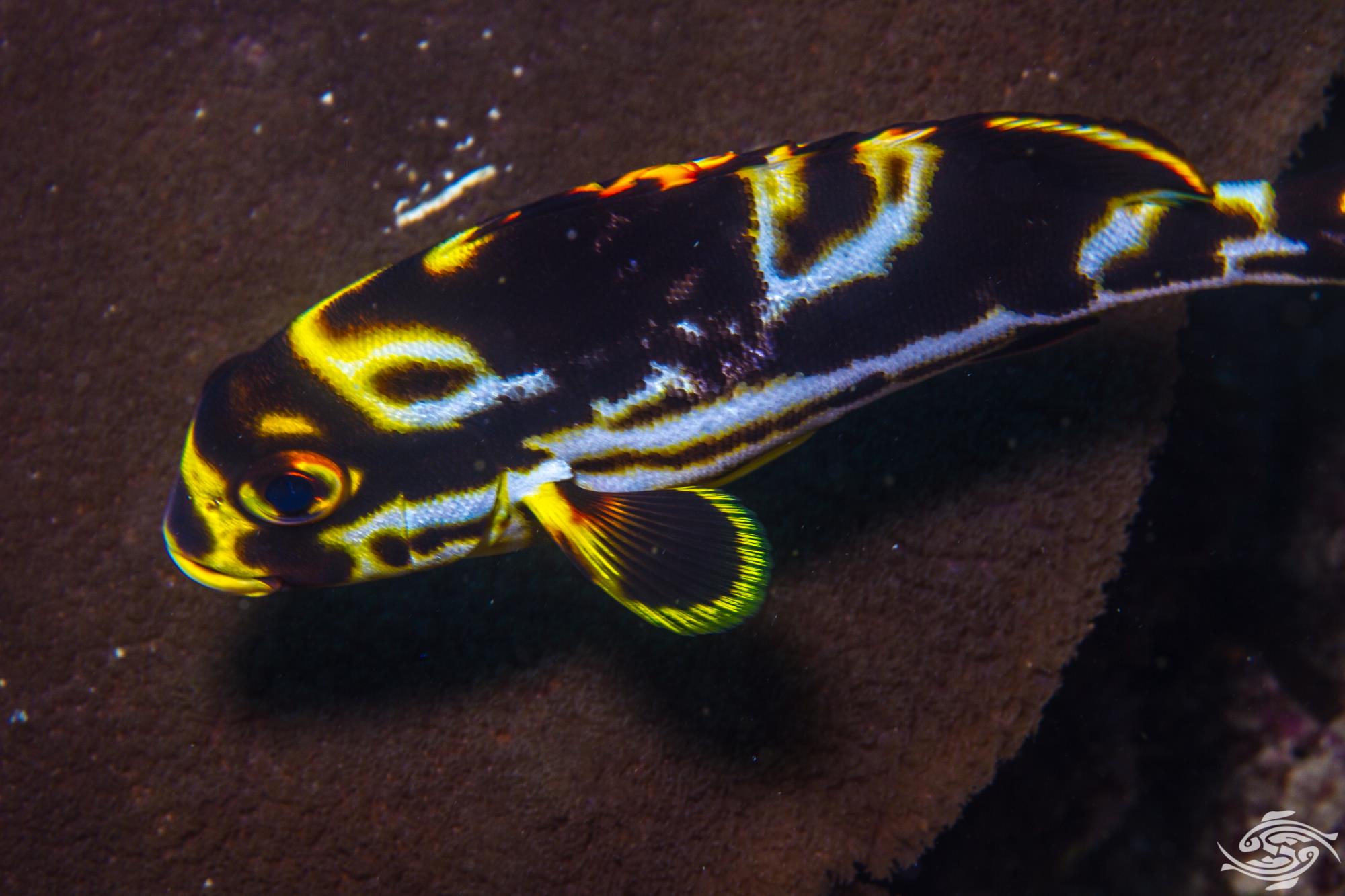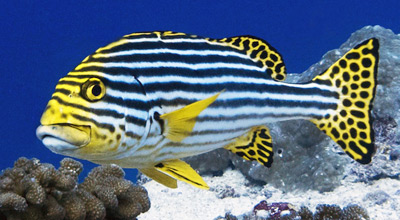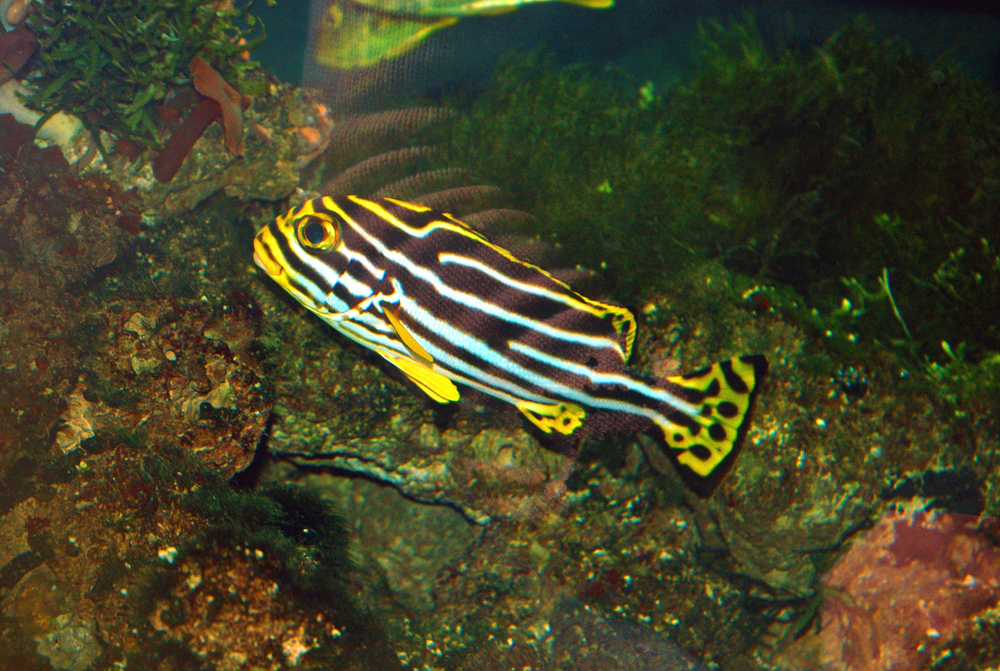
The Oriental Sweetlips fish, scientifically known as Plectorhinchus orientalis, is a species of marine fish that belongs to the Haemulidae family. These fascinating creatures are widely recognized for their vibrant colors, unique patterns, and distinctive appearance. The Oriental Sweetlips fish is native to the warm waters of the Indo-Pacific region, including the Red Sea, South Africa, and the Great Barrier Reef.
One of the most striking features of the Oriental Sweetlips fish is its large mouth, which gives it a distinct “sweet lips” appearance. This fish can grow up to 60 centimeters in length and is characterized by its elongated body shape. It has a beautiful combination of pale pink and yellow markings that vary in intensity and pattern depending on the individual. The Oriental Sweetlips fish is known for its bright yellow fins, giving it a truly captivating and eye-catching appearance.
When it comes to their habitat, Oriental Sweetlips fish are commonly found in coral-rich areas, including reefs, lagoons, and sandy bottoms. They are highly adaptable and can thrive in various depths, ranging from shallow waters to depths of up to 60 meters. These fish prefer warm waters and are commonly spotted in tropical and subtropical regions.
Behaviorally, Oriental Sweetlips fish are generally solitary creatures, especially during the day when they tend to hide among coral crevices or under rocky overhangs. However, during the night, they become more active and venture out in search of food. Their diet primarily consists of small crustaceans, mollusks, and other small marine organisms.
Overall, the Oriental Sweetlips fish is an incredibly fascinating marine species. Its vibrant colors, unique appearance, and interesting behaviors make it a popular subject for underwater photographers and an attraction for marine enthusiasts. Hopefully, increased awareness and conservation efforts will ensure the preservation of their natural habitats and allow these beautiful fish to thrive for generations to come.
Oriental Sweetlips Fish
The Oriental Sweetlips Fish, also known as Plectorhinchus orientalis, is a species of fish that belongs to the family Haemulidae. It is native to the waters of the Indian Ocean and the western Pacific Ocean, including the Red Sea, the Maldives, and the Great Barrier Reef.
These fish are easily recognizable due to their unique appearance. They have a large mouth, thick lips, and a pointed snout. The body of the Oriental Sweetlips Fish is elongated and can grow up to 60 centimeters in length. They have a beautiful color pattern, with a yellowish base color and various orange, white, and black markings.
The Oriental Sweetlips Fish is typically found in coral reefs, lagoons, and rocky areas with plenty of hiding spots. They prefer warm waters with moderate currents. These fish are known to be territorial and often stay in pairs or small groups. They are most active during the night, feeding on small invertebrates and fish.
One interesting behavior of the Oriental Sweetlips Fish is its ability to change color. They can rapidly change their color pattern to match their surroundings, helping them to camouflage and avoid predators. This adaptive behavior is especially important for their survival in the wild.
Despite their unique and attractive appearance, Oriental Sweetlips Fish are not commonly kept in home aquariums. They require spacious tanks with plenty of hiding spots and a varied diet. It is also important to provide them with appropriate water conditions and maintain good water quality.
In conclusion, the Oriental Sweetlips Fish is a fascinating species that can be found in the waters of the Indian Ocean and the western Pacific Ocean. With their distinct appearance and interesting behaviors, they are a delight to observe in their natural habitat.
Characteristics

The Oriental Sweetlips fish, also known as the Plectorhinchus Orientalis, is a species native to the Indo-Pacific region. It is characterized by its vibrant colors, large lips, and elongated body shape. These fish can grow up to 60 centimeters in length and weigh up to 7 kilograms.
The Oriental Sweetlips fish has a distinctive appearance, with its body covered in a mixture of brown, yellow, and white colors. It has a unique pattern of black spots and lines that run along its body, giving it a mesmerizing appearance. The lips of this fish are large and pucker-like, which is how it gets its name.
One of the most interesting characteristics of the Oriental Sweetlips fish is its ability to change color. This fish can adjust its coloration to blend in with its surroundings, helping it to camouflage and avoid predators. It can also change color to communicate with other fish or to display aggression.
| Characteristics | Details |
|---|---|
| Scientific Name | Plectorhinchus Orientalis |
| Size | Up to 60 centimeters |
| Weight | Up to 7 kilograms |
| Colors | Brown, yellow, white |
| Lip Shape | Large and pucker-like |
| Color Change | Can adjust coloration to blend in with surroundings or communicate |
Overall, the Oriental Sweetlips fish is a fascinating species with its vibrant colors, unique patterns, and ability to change color. Its large lips and elongated body make it stand out among other fish in the region.
Habitat

The Oriental Sweetlips fish can be found in the warm, tropical waters of the Indo-Pacific region, including the Red Sea, Indian Ocean, and the Pacific Ocean. They inhabit coral reefs, lagoons, and outer reef slopes, often in areas with strong current and plenty of hiding places.
These fish prefer to live in depths ranging from 5 to 50 meters, although they can occasionally be found in shallower waters and even as deep as 100 meters. They are commonly found near the bottom of the reef, where they can feed on a variety of small fish, crustaceans, and other invertebrates.
The Oriental Sweetlips fish is known to be a solitary species, meaning they are typically found alone or in small groups. However, during the breeding season, which occurs between the months of April and August, they may form larger aggregations to spawn.
Prefered Habitat Characteristics
These fish are attracted to areas with an abundance of coral formations, as they provide shelter and protection. They also prefer areas with clear water and moderate to strong currents, as these conditions bring an ample supply of food.
Additionally, the Oriental Sweetlips fish has been observed to exhibit a preference for areas with sandy or muddy substrates near the reef, where they can dig into the sediment to find prey or take a rest. They are also known to use coral heads, crevices, and overhangs as resting places throughout the day.
Threats to Habitat
However, the habitat of the Oriental Sweetlips fish is under threat from various human activities. Overfishing and destructive fishing practices, such as the use of cyanide and dynamite, can significantly damage coral reefs and deplete fish populations.
Pollution and climate change also pose significant threats to their habitat. Increased water temperatures, ocean acidification, and coral bleaching events can negatively impact the health of coral reefs and the availability of food sources for the Oriental Sweetlips fish.
Conservation efforts, such as the establishment of marine protected areas and the promotion of sustainable fishing practices, are essential for preserving the habitat of this unique and beautiful fish species.
| Water Temperature | Depth | Preferred Substrate |
|---|---|---|
| 24°C – 30°C | 5m – 50m | Sandy or muddy substrates near reefs |
Behaviors
The Oriental Sweetlips fish is known for its beautiful and captivating behaviors. Here are some interesting behaviors exhibited by this species:
- Camouflaging: When it feels threatened or wants to hide from predators, the Oriental Sweetlips fish is capable of changing its color and patterns. It uses this ability to blend in with its surroundings, making it difficult for predators to spot.
- Schooling: This fish species often forms large social groups known as schools. By staying together in a school, Oriental Sweetlips fish are able to improve their chances of survival. They communicate with each other through various body movements and signals.
- Feeding: The Oriental Sweetlips fish is predominantly a carnivorous species. It actively hunts for small fish, crustaceans, and other invertebrates. Its feeding behavior is characterized by quick bursts of speed and precise strikes to capture prey.
- Communication: Oriental Sweetlips fish have a complex system of communication. They use various sounds, movements, and visual displays to communicate with other members of their species. These behaviors help establish territories, court mates, and warn others of potential threats.
- Breeding: During the breeding season, the Oriental Sweetlips fish display a unique courtship behavior. Males engage in elaborate displays, including shimmering their bodies and changing colors to attract females. Once a mate is chosen, the female lays her eggs, and the male fertilizes them externally.
- Migratory Patterns: Oriental Sweetlips fish are known to exhibit migratory behaviors. They travel long distances in search of food, suitable breeding grounds, or to escape unfavorable conditions. These migrations can sometimes span hundreds of kilometers.
Overall, the Oriental Sweetlips fish demonstrates a fascinating range of behaviors that contribute to its survival and reproduction in its natural habitat.
Appearance and Coloration
The Oriental Sweetlips fish, scientifically known as the Plectorhinchus vittatus, possesses a distinctive and captivating appearance. It showcases a large, elongated body and a triangular-shaped head. Growing up to 70 centimeters in length, this fish is hard to miss in the underwater world.
One of the most striking features of the Oriental Sweetlips is its vibrant and eye-catching coloration. The body of this fish is characterized by a combination of bold and contrasting colors, making it a true spectacle to behold. The background color of the body ranges from silver to gray, which is accented by vertical bands of black or dark brown.
The head of the Oriental Sweetlips boasts a beautiful blend of colors. It typically has a yellowish hue with intricate patterns of black lines that extend from the eyes towards the mouth. The vibrant colors and distinct patterns on the head of this fish add to its overall allure.
In addition to its remarkable coloration, the Oriental Sweetlips has a set of enchanting and lively eyes. The eyes are relatively large, positioned towards the front of the head, and have a vibrant yellow color. These captivating eyes not only contribute to the fish’s appealing appearance but also serve a functional purpose in aiding its vision and hunting skills.
Sexual Dimorphism
When it comes to sexual dimorphism, the Oriental Sweetlips exhibits minimal differences between males and females in terms of appearance and coloration. Both genders share similar body shapes, patterns, and coloration. This makes it challenging to differentiate between males and females based solely on their physical traits.
Juvenile Coloration
It is worth noting that the coloration of the Oriental Sweetlips fish changes as it transitions from a juvenile to an adult. Juvenile Oriental Sweetlips display strikingly different colors compared to adults. They have a predominantly yellow coloration with black stripes, giving them a highly unique and mesmerizing appearance. As they mature into adulthood, their coloration undergoes a transformation to the distinct pattern of silver or gray with vertical bands.
| Common Name: | Oriental Sweetlips |
|---|---|
| Scientific Name: | Plectorhinchus vittatus |
| Length: | Up to 70 centimeters |
| Coloration: | Silver, gray, black, dark brown, yellow |
Feeding Habits
The Oriental Sweetlips fish is primarily a carnivorous species, meaning it mainly feeds on other smaller fish, crustaceans, and mollusks. Its diet consists of a variety of marine animals, including shrimps, crabs, worms, and small fishes.
These fish have a unique feeding behavior. They are ambush predators, relying on camouflage and patience to catch their prey. They often blend in with their surroundings, such as coral reefs or rock formations, and wait for their food to swim by. Once a suitable prey item is within striking distance, the Oriental Sweetlips fish uses its quick and powerful mouth to snatch it up.
Due to their large mouths and sharp teeth, Oriental Sweetlips fish are also capable of eating smaller crustaceans and mollusks found on the seafloor. They use their mouths to crush shells and extract the soft flesh inside.
These fish have a voracious appetite and can consume a significant amount of food in one feeding session. They have a high metabolic rate, which allows them to digest and process their meals quickly.
It is important to note that Oriental Sweetlips fish are not picky eaters and will easily adapt to a varied diet in captivity. However, it is recommended to provide them with a balanced diet consisting of small live or frozen foods, such as brine shrimp, mysis shrimp, and small fish fillets.
Fun Fact: The Oriental Sweetlips fish can consume prey that is up to two-thirds of its own length!
Reproduction and Life Cycle
The Oriental Sweetlips fish undergoes sexual reproduction. They are oviparous, which means that they produce eggs that hatch outside the mother’s body. These fish have a unique spawning ritual where the male and female swim together in a circular pattern, releasing eggs and sperm into the water column.
Spawning Behavior
During spawning, the male Oriental Sweetlips fish will display brighter colors and increased aggression. They compete for the attention of the female, trying to establish dominance. Once the female selects a dominant male, they will initiate the spawning behavior.
After releasing their eggs and sperm into the water column, the Oriental Sweetlips fish do not provide any parental care for their offspring. The eggs are left on their own, exposed to various environmental factors and predators. This is known as pelagic spawning, where the eggs drift with the ocean currents.
Life Cycle
Once the eggs hatch, the larval fish, known as fry, are highly vulnerable and rely on their ability to hide and camouflage themselves for survival. They go through a pelagic larval stage, where they drift with the currents and feed on plankton. As they grow, they gradually transition into a benthic lifestyle.
The Oriental Sweetlips fish reach sexual maturity at around 3-4 years of age. Their lifespan can vary depending on various factors, but they typically live for 15-20 years in the wild.
Throughout their life cycle, these fish play an important role in the marine ecosystem. They contribute to the balance of coral reefs by feeding on smaller organisms and providing food for larger predators.
Q&A:
Where can Oriental Sweetlips fish be found?
Oriental Sweetlips fish can be found in the Indo-West Pacific region, including the coasts of Australia, Indonesia, and the Philippines.
What are the physical characteristics of Oriental Sweetlips fish?
Oriental Sweetlips fish have a laterally compressed body and a distinctive head shape. They have a vivid color pattern with yellow, white, and black stripes, and their lips are thick and fleshy.
What is the habitat of Oriental Sweetlips fish?
Oriental Sweetlips fish are commonly found in coral reefs and rocky areas. They prefer shallow waters with plenty of hiding spots, such as caves and crevices.
What do Oriental Sweetlips fish eat?
Oriental Sweetlips fish are carnivorous and feed on a variety of prey, including small fishes, crustaceans, and mollusks. They have relatively large mouths, which they use to engulf their prey whole.
Are Oriental Sweetlips fish territorial?
Yes, Oriental Sweetlips fish are territorial and can be aggressive towards other fish that invade their space. They prefer to stay in small groups or pairs and establish territories within their habitat. However, they are generally not aggressive towards humans.
What are the characteristics of Oriental Sweetlips Fish?
Oriental Sweetlips Fish are known for their distinctive appearance. They have a large body with a rounded head and pouty lips, which gives them their name. They are usually brightly colored with patterns or spots on their bodies. They can grow up to 24 inches in length and weigh up to 11 pounds.
Where can Oriental Sweetlips Fish be found?
Oriental Sweetlips Fish are native to the Indo-West Pacific region, including the Red Sea, the coast of East Africa, and the coastal waters of the Indian Ocean. They are commonly found near coral reefs, rocky habitats, and lagoons, where they can hide and feed on small invertebrates.